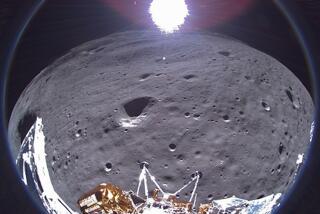An Era in Space Ends as Russia Abandons Mir
KOROLYOV, Russia — With a sad smile and a final wave to Earth, the commander of Russia’s Mir space station floated out of the main module late Friday and pulled the hatch shut behind him, effectively bringing Mir’s 13-year working life to an end.
It was a moment of wrenching grief for Russia’s space community. Normally cool space officials fought back tears as they watched the farewell to Mir, among them Mikhail L. Pronin, chief engineer at the flight control center in Korolyov, just north of Moscow.
“When I saw the hatch closing, I was overwhelmed with such sadness that I could barely control myself,” said Pronin, his eyes glistening and hands trembling as they fiddled with a pack of cigarettes. “It was hard for me to watch, and it’s hard for me to speak now,” he said a few minutes after the crew departed Mir, leaving the station to orbit unmanned and aimless. The crew landed this morning on a deserted steppe in the former Soviet republic of Kazakhstan.
Mir commander Viktor Afanasyev summed up the cosmonauts’ emotions in a brief farewell. “We’re leaving this little piece of Russia with bitterness in our souls,” he said, his voice barely audible through crackling static.
Having switched Mir’s systems to automatic, Afanasyev and crew members Sergei Avdeyev and Frenchman Jean-Pierre Haignere departed Mir shortly after 10 p.m. Moscow time, and the screens at the flight control center went blank. Unless funds for another crew are found--an unlikely prospect--the station is scheduled to burn up in Earth’s atmosphere in the spring.
The moment symbolized the end of Russia’s leadership in space. It sent up the first sputnik in 1957 and put the first man, Yuri Gagarin, in orbit in 1961. Mir, one of the last vestiges of Russia’s superpower era, is where cosmonauts set extraordinary space endurance records. Now, the high costs of running the station--$200 million a year--have forced Russia’s space agency to abandon it.
Mir veteran Valery Polyakov, who spent a record 438 days in space, Friday described Mir’s death as “unspeakably painful.”
“This is a crippling blow to the Russian space industry. . . . Mir is like a child to all of us who worked there.”
The cosmonauts’ departure Friday leaves Russia without a major space project of its own. So great is the sense of loss that few in the space community admit this is really the end for Mir.
Flight engineer Avdeyev said the crew was leaving the station in good condition “for those who want to come and work here.”
“I don’t want to believe that our program is coming to an end,” said Pronin, reflecting space officials’ desperation to somehow find the money to staff Mir and prolong its life for a few more years. “I hope, no I believe, that we will see that hatch open and close many times again.”
The big fear for Russian space officials is that Mir may malfunction when left unmanned. Even with a crew working on repairs--and sometimes doing little else--the severe technical difficulties in Mir’s final few years underscore this risk. One scenario is that Mir may seize up entirely and become a frozen hunk of orbiting metal--but space officials believe it could be saved even then.
“It’s not going to be easy, but we’re ready to face the difficulties connected with the fact it was left unmanned and some equipment might not be working,” said Leonid Gorshkov, one of Mir’s designers, now deputy director of the design department at the Russian space agency Energia. It has been done before, in the mid-1980s, when the Russians succeeded in rescuing the frozen Salyut 7 station after it failed completely when unmanned.
“Mir works at full capacity. It still has a great future, and we’ve taken great pains to create it. It’s no more dangerous to fly in the space station now than it was in the early years,” said Gorshkov, arguing the space station should not be brought down before the International Space Station, a 16-country joint venture, is manned next year.
Senior officials in the Russian government take a different view. Among Mir’s 1,500 problems were leaks, malfunctioning oxygen systems and, in the station’s worst year, 1997, a fire and a near-fatal collision with a cargo ship that punctured the Spektr module, rendering it uninhabitable.
Apparently unembarrassed, Russian space officials shrugged the problems off, explaining the station was originally designed to fly only five years and had far exceeded expectations. Russian cosmonauts, expert at space repairs, managed to fix the problems as they arose.
NASA officials are alarmed by attempts to keep Mir in orbit because these efforts could divert funding from Russia’s sections of the international station, already running 18 months behind schedule.
“Our American colleagues try to be polite and careful. But I understand they are worried. They know that Russia has limited means and financial problems, and our future is not clear. They never tell us we should bring it back--but I know they’d be relieved if we did,” said Gorshkov, smiling ruefully.
Early this year, Russia’s government ordered the space agency to find its own funds to run Mir. One financing scheme tried to lure private individuals who would pay to fly to the station, but that failed dismally. A last-ditch attempt is even more desperate--it calls for ordinary people to dip into their savings to deposit money into a Russian bank account, “so the world can help keep Mir in space,” said former Mir and Salyut cosmonaut Alexander Alexandrov.
If more funds are not found, there will be only one more crew--the cleanup team that will take scientific equipment out of Mir and prepare the station to be guided out of orbit and burned up on reentry, with several large chunks to be aimed at the Earth’s oceans.
Cosmonaut Polyakov said it will be disastrous if Mir is brought down. “Russia will at least temporarily lose its leading position in space.”
Stranded on Earth, Alexandrov misses Mir, the thrill of looking down on the planet and 16 sunsets every day. He even liked the food.
“We always had the same fantastic atmosphere on Mir, and it was the same for the whole 13 years.” Like many colleagues, he is unwilling to admit there were ever any problems with the space station. It would be like speaking ill of the dead.
Sergei L. Loiko of The Times’ Moscow Bureau contributed to this report.
(BEGIN TEXT OF INFOBOX / INFOGRAPHIC)
77,000 Orbits, 1,500 Problems
Some statistics about the Mir space station:
Launch date: February 1986
ORBITS: About 16 a day, for total of more than 77,000.
DAYS ALOFT: Close to 5,000 for Mir’s core component.
Distance from Earth: About 225 miles.
Problems: About 1,500, including a near-fatal collision with a cargo ship in June 1997 and an on-board fire earlier that year.
PASSENGERS: Nearly 100, including seven NASA astronauts
Next step: Though some Russian space officials hope that money can be found to keep the MIR program alive, the mission is expected to end for good next year.
On Friday, the crew switched the station to autopilot and departed on its Soyuz spacecraft. Tentative schedule for Mir’s descent:
Over next six months: Power will be reduced; station’s orbit above Earth will sink from the current 225 miles to about 200 miles.
February or March 2000: Cleanup crew arrives to dismantle equipment and retrieve experiments.
Cleanup crew leaves. Mir is expected to hit Earth’s atmosphere and burn up.
Krystall module: (1990)
Kvant-2 module: (1989)
Mir space station: (Year represents when modules added to station)
Spektr module: (1995)
Mir core module: (1986)
Kvant-1 module: (1987)
Prioda module: (1996)
Sources: NASA, Energiya, Associated Press
More to Read
Sign up for Essential California
The most important California stories and recommendations in your inbox every morning.
You may occasionally receive promotional content from the Los Angeles Times.










